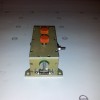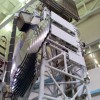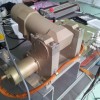TUS
Space telescope TUS
Orbital telescope TUS (Russian abbreviation for “Tracking Instrument”) is intended for the observations of UV radiation (300-400 nm wavelength)bursts in the night atmosphere of the Earth.
What’s an idea of the measurement method?
TUS instrument onboard the satellite includes a mirror-concentrator of about two meters diameter with a receiver of UV radiation – mosaic consists of 256 photomultiplyers – located in its center. Such space telescope will allow to detect UV radiation of the AUger showers from the particles, penetrating into the night atmosphere – in fact, very fast (microseconds’ duration) tracks of the charged particles. A number of registered photons provides information for estimation of the primary particles’ energy. Flux of these particles is very small (at energy of 1019 eV at the Earth it is about 1 particle per km2 per year!) and possibility of their registration makes the space method a hands-down winner comparing with the ground-based instruments.
Parameters of the device
| Area of the mirror, m2 | 1,8 |
| Focal disnance, cm | 150 |
| Size of a cell, mm | 15×15 |
| Number of cells | 256 |
| Time step, mks | 0,8 |
| Orbit’s altitude, km | 500 |
| Energetic threshold for the extremely high energy cosmic rays’ particles, eV | 7 1019 |
| Area of the atmosphere observation, km2 | 6400 |
| Track measurement step, km | 5 |
 Lomonosov
Lomonosov


